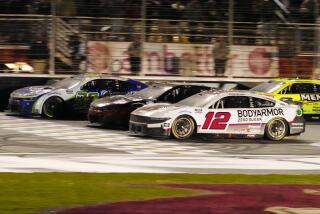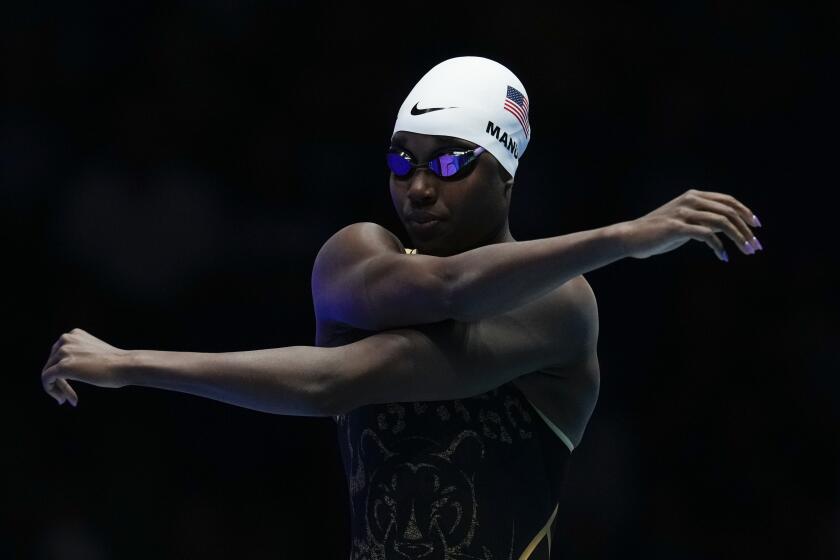Rescuer: Seat Belt Wasn’t Broken
Dale Earnhardt’s seat belt did not break during his fatal crash at the Daytona 500, according to one of the first rescuers to come to his aid.
Tommy Propst of Orlando, a veteran firefighter and emergency medical technician, said he found the NASCAR legend strapped inside his crumpled car in the infield of the Daytona International Speedway and that the seat belt was tight enough that he had to pull on the buckle repeatedly before it popped open.
“Somebody hollered, ‘I’ll cut it.’ I said, ‘No, let me try it.’ I reached over, pulled, and I had to really jerk. I pulled hard, and that’s when it come open. If it would have been broke, the whole thing would have come open. . . . It was in one piece at the time.”
Propst’s account breaks two months of silence by those who tried to save Earnhardt. It also raises questions about NASCAR’s crash investigation and the racing organization’s claim that Earnhardt’s left lap belt broke when his No. 3 Chevrolet hit the wall during the final lap of the race Feb. 18.
But, Propst said, he has never been questioned by anyone from NASCAR.
“If they’re doing this big investigation and they wanted to know the truth, why wouldn’t they interview the one that took the seat belt off?” he asked.
NASCAR officials Saturday refused to respond to Propst’s statements. Questioned at the California Speedway, site of today’s NAPA Auto Parts 500, NASCAR President Mike Helton said he had no comment.
NASCAR Chairman Bill France Jr. angrily accused the Sentinel of not being interested in hearing NASCAR’s side of the story.
‘I’m not going to talk to you about any of that stuff,” France added. “ . . . we’ve got a lot more to do than mess with that damn . . . .”
NASCAR has not shown Earnhardt’s seat belt publicly. It says the crash is being investigated by world-class experts it has not identified. The findings are not expected before August--and NASCAR has said it may not disclose details of the investigation.
Speedway videotapes and other rescuers identify Propst, 49, as one of the most active members of the Earnhardt rescue team. A certified EMT and firefighter for 24 years, he was working at the Speedway on an ambulance stationed just a few hundred feet from the crash.
His eyewitness account, volunteered after weeks of indecision and pained discussions with his fellow firefighters, adds significantly to an already heated controversy over how NASCAR’s most popular driver died.
An autopsy of the seven-time Winston Cup champion found that the impact of the crash cracked the base of his skull and caused massive internal head injuries. He died almost instantly.
Before the Daytona tragedy, three other drivers had died of similar injuries in the previous year, raising questions about whether NASCAR should join other racing organizations in requiring drivers to wear new devices that keep the head and neck from being thrown violently forward.
Five days after the crash, NASCAR officials introduced a new element: a broken lap belt. The belt was part of a five-point harness of three-inch nylon webbing--consisting of two shoulder belts, two lap belts and a crotch strap--held together by a single latch.
Bill Simpson, whose Simpson Performance Products made the belt assembly used by Earnhardt and by most NASCAR drivers, says the system has never failed in a Winston Cup car.
Gary Nelson, head of NASCAR’s Winston Cup racing, told reporters on Feb. 23 in Rockingham, N.C.:
“What we found in the accident investigation was that this left side [lap belt] had separated, even though it was buckled. When the safety crew got to him, this part here”--Nelson then held up an intact lap belt--”was not connected to the roll cage anymore. There was a separation right in this area--it became two pieces.”
The lap belt is anchored to the floor of the car.
Asked if the belt broke at a metal fitting, Nelson said, “It was the webbing. The metal was still intact at each end.”
Could rescuers have cut it?
“We’re not going to get into any details about the cut, other than we had two pieces,” Nelson said. “We talked to the rescue people that were on the scene. We got their statements and that led us to try to understand exactly how something like this could happen. We think it happened during the accident, some time.”
At the same news conference, the Speedway’s emergency medical services director, Dr. Steve Bohannon of Daytona Beach, theorized that the break contributed to Earnhardt’s death. NASCAR and Bohannon have backed off that analysis, however, since a court-appointed crash researcher from Duke University concluded that Earnhardt’s head would have whipped violently forward--causing the basilar skull fracture--regardless of whether the belt held or broke during the crash.
Propst, however, insists the seat belt did not break. Nor, he says, did he see it cut.
Videotapes recorded from Speedway cameras and Fox Sports show rescue workers, among them Propst and his partner, Jason Brown, reached Earnhardt’s car less than 30 seconds after the crash.
Propst said the collision didn’t look that serious, even though Earnhardt’s car had been going about 180 mph when he lost control. As he started up the ambulance, Propst heard Brown say, “I don’t want to go out there. He’s going to be madder than hell.”
Propst said he and Brown, 33, a paramedic from Chuluota, Fla., expected to find Earnhardt uninjured but in a rage over crashing while running third on the last lap of the Daytona 500.
Instead, the rescuers found the driver motionless in his seat, his head on his chest and his right hand and arm on a spoke of the steering wheel. The wheel was bent to the right.
Propst said that Earnhardt’s shoulder belts were stretched about four inches, either because of the force of the crash or because he had loosened them during the race.
“Jason raised his head up. He had those cold, steel eyes,” Propst said. “We actually looked at each other and, you know, we knew right then that he was dead.”
“We need 99 and the tool,” Propst said he radioed to rescue officials, using the code for a doctor and the extraction crew.
Their first task: Undo the chin strap of Earnhardt’s helmet, open his airways and remove the seat belts.
Brown grabbed a pair of scissors off his utility belt--the only cutting instrument Propst said was used inside the vehicle--and leaned in through the car window to cut the chin strap but the scissors blades twisted, Propst said, adding, “It never did cut.”
Videotape shows Brown put the scissors on the car’s roof. He then leaned back inside and undid the chin strap by hand so he could open Earnhardt’s mouth to force air into his lungs, Propst said.
By then, another rescuer aboard Propst’s ambulance, Patti Dobler, 37, of Winter Park, had climbed into the car through the right-side window, the videotape shows. Propst said she began tugging at Earnhardt’s seat belt but couldn’t get it to budge.
Propst said he leaned into the car and reached across Earnhardt’s body to grab the Velcro tab covering the buckle’s latch. The mechanism was wedged tightly against Earnhardt’s body.
“She said she couldn’t get it off because it was kind of jammed into his side,” Propst said. Propst, a stocky, powerful man, said the lap belt was stretched tight--and the latch initially didn’t budge.
“I was jerking here,” he said, pointing to the latch on a set of seat belts identical to Earnhardt’s. “When it finally come loose, it come loose.
“Then I laid this part [the left-hand side of the lap belt] over to the left [of Earnhardt], and I did not see any broken cuts of the seat belt. It was in one piece at the time.”
Paramedics and doctors say Brown, Propst and the other rescuers faced an impossible task. There is no way to adequately perform CPR on a seated victim, much less one trapped inside a race car without doors.
Still, said Propst, “I never give up. I mean, we worked on him the best we could and they worked on him the whole way to the hospital.”
Alfred L. Alson, a surgeon from Palm Coast, was the first of the Speedway doctors to reach Earnhardt, joining Brown and Propst at the driver’s side window.
Alson, who has worked part-time at the track since 1988, reached his left arm through the window, unzipped Earnhardt’s racing suit and started CPR with one hand. He said it was the best he could do as he shared the 3-foot-by-18-inch window with the two other rescuers.
Meanwhile, Brown forced air into Earnhardt’s lungs, using a squeeze pump. Propst said he supported the driver’s head and neck.
Alson did not recall seeing the seat belts because they’d already been moved out of his way.
Bohannon, who arrived after Alson, said he did not see the interior of the car, or the seat belt, at the track. He said he later saw the allegedly broken belt at a NASCAR garage in North Carolina a few days later and was not allowed to comment on it.
Eight-and-a-half minutes after the rescue began, Earnhardt’s body was loaded into an ambulance and taken to Halifax Medical Center in Daytona Beach. Though doctors continued to work frantically to revive him, he was pronounced dead shortly thereafter.
Propst’s story spotlights the lack of independent information about what happened in the crash. Since that Sunday afternoon, no one but NASCAR and Speedway officials has had access to the car or the seat belts. Daytona Beach police did not examine or photograph the interior of Earnhardt’s car on the night of the crash. Nor did NASCAR notify police that it had found the broken seat belt that night, according to the lead police investigator.
Detective Robert Walker told the Sentinel last month that police learned of the seat belt issue five days later from the televised news conference. Had he known earlier, he said, he would have seized the belt as evidence and sent it to a police laboratory.
Furthermore, he said, a supervisor had instructed him not to photograph the car on the night of the crash, not to inspect it and not to attend Earnhardt’s autopsy.
Four of Propst’s Speedway colleagues who worked on the wreck declined to talk about the crash, saying track officials had told them not to. Officials at the Speedway, which is controlled by the France family, said they prefer to arrange and attend interviews of track personnel. Asked several times last week to arrange such interviews, spokesman Glyn Johnston said he’d try--but hadn’t done so by Saturday.
One who declined comment was Dobler, the rescuer whom Propst said first tugged at Earnhardt’s seat belt.
“I was in the car with [Earnhardt],” she said. “I know the truth, and I’m not allowed to talk.”
Contradicting Nelson’s statement that NASCAR “talked to the rescue people that were on the scene,” Propst said he was never questioned about the belt or the rescue. When Propst asked his track supervisor why he hadn’t been interviewed--adding that he knew the seat belt hadn’t broken--the supervisor told him he had simply forgotten to give the firefighter’s name to NASCAR officials, Propst said.
“I just can’t understand why, you know, that I wasn’t questioned in their investigation by anyone,” Propst said, adding that Brown told him he and Dobler were questioned.
Paramedic Daniel Gass, who serves as the Speedway’s assistant chief of emergency medical services, was the supervisor Propst spoke to. Gass declined to discuss the crash without permission from Speedway officials.
“I assure you, there is no cover-up going on,” Gass said.
After the race, NASCAR stored Earnhardt’s car behind a chain-link fence at the firefighters’ compound at the Speedway, where rescue workers held a somber post-race cookout. Fire Rescue Lt. Mark Ratta, who had worked at the track that day, remembers seeing only three men approach the car that evening--the time NASCAR later said the broken seat belt was discovered.
A tarp covering the wreckage was pulled aside, and at least one of the men took flash photographs of the interior, Ratta said. He thought they were Daytona Beach Police detectives or investigators for the Volusia County medical examiner’s office.
But neither agency reported taking photographs of the car that evening. They took pictures the next morning, after Ratta had helped push the car into a trailer for shipping to North Carolina.
None of the pictures taken that Monday morning--the only ones publicly available--show Earnhardt’s cockpit clearly enough to resolve the belt controversy.
Besides Propst, the only available evidence that the belt held firm comes from autopsy records. The Volusia County medical examiner’s report states that doctors found seat belt abrasions about eight inches long by two inches wide on Earnhardt’s right hip and about four inches long by one inch wide on his left hip.
In his independent analysis, Barry S. Myers, the Duke University biomedical expert who studied the autopsy photographs under an agreement between the Sentinel and Earnhardt’s widow, accepted NASCAR’s statement that the belt had failed. But he did note that “the restraint system functioned to slow Mr. Earnhardt’s body. This includes the outboard lap belt for some significant portion of the crash.”
Myers wrote that a medical examiner’s photograph of the cockpit of Earnhardt’s Chevrolet shows the left lap-belt webbing was “separated and appears torn.” But others who studied the photo say they believe the webbing is part of a window safety net, not the seat belt.
Propst said he went public, in part, because he is not sure the Earnhardt family really knows what happened.
Despite his 24 years of seeing death and injury as a firefighter, Propst said he can’t shake his discomfort over the death of his favorite racer, a man he had cheered for years. Like many racing fans, he claims a special bond with Earnhardt.
*
Tribune motor sports writer Ed Hinton contributed to this story.
More to Read
Go beyond the scoreboard
Get the latest on L.A.'s teams in the daily Sports Report newsletter.
You may occasionally receive promotional content from the Los Angeles Times.





